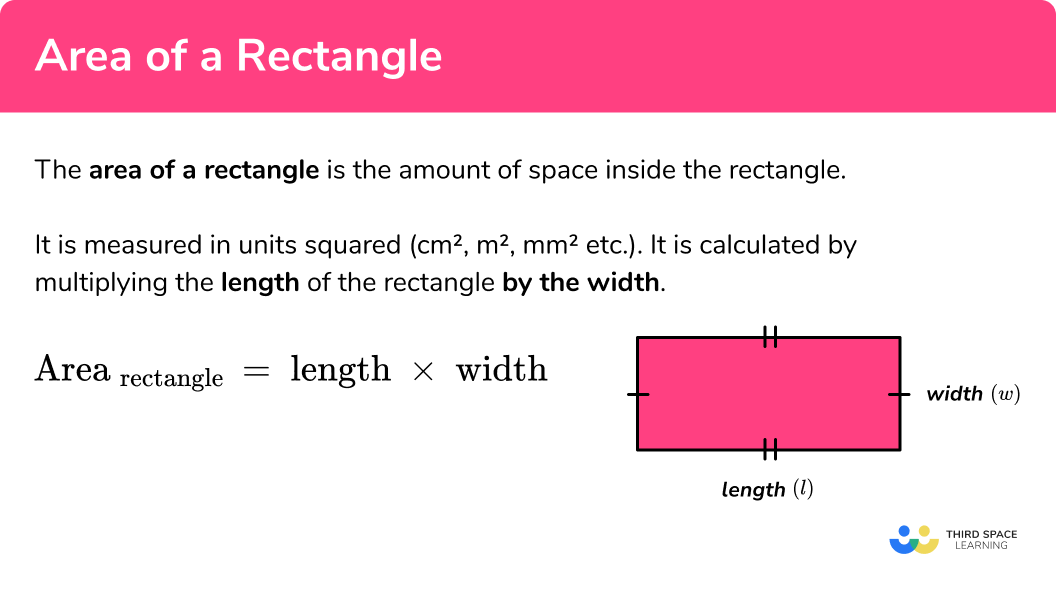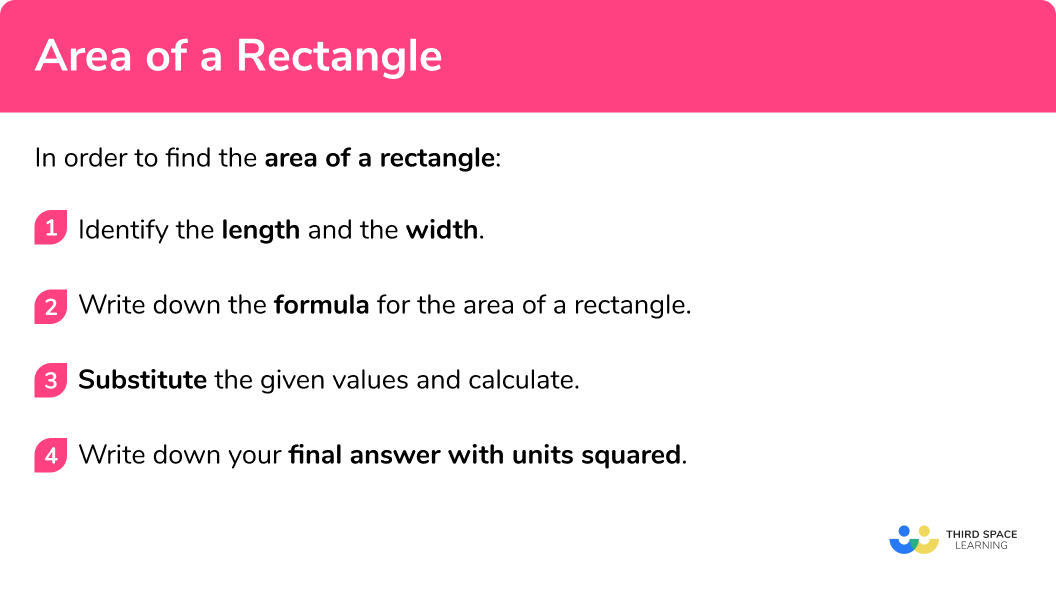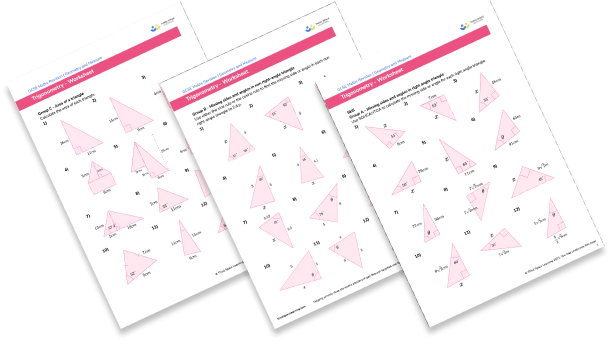GCSE Tutoring Programme
Our chosen students improved 1.19 of a grade on average - 0.45 more than those who didn't have the tutoring.
This topic is relevant for:

Area Of A Rectangle
Here we will learn about finding the area of a rectangle, including compound area questions, questions with missing side lengths and questions involving unit conversion.
There are also area of a rectangle worksheets based on Edexcel, AQA and OCR exam questions, along with further guidance on where to go next if you’re still stuck.
What is the area of a rectangle?
The area of a rectangle is the amount of space inside the rectangle. It is measured in units squared ( cm^{2}, m^{2}, mm^{2} etc.)
A rectangle is a quadrilateral ( 4 sided shape) where every angle is a right angle ( 90° ) and the opposite sides are of equal length.
The area of a rectangle is calculated by multiplying the length of the rectangle by the width.
Area of a rectangle formula:
\text { Area }_{\text {rectangle }}=\text { length } \times \text { width }
Our final answer must be in units squared
E.g.
Square centimetres (cm^{2}) , square metres (m^{2}) , square feet (ft^{2}) etc.
What is the area of a rectangle?

How to find the area of a rectangle
In order to find the area of a rectangle:
- Identify the length and the width
- Write down the formula for the area of a rectangle
- Substitute the given values and calculate
- Write down your final answer with units squared
How to find the area of a rectangle


Area of a rectangle worksheet

Get your free Area of a rectangle worksheet of 20+ questions and answers. Includes reasoning and applied questions.
DOWNLOAD FREE
Area of a rectangle worksheet

Get your free Area of a rectangle worksheet of 20+ questions and answers. Includes reasoning and applied questions.
DOWNLOAD FREERelated lessons on area
Area of a rectangle is part of our series of lessons to support revision on area. You may find it helpful to start with the main area lesson for a summary of what to expect, or use the step by step guides below for further detail on individual topics. Other lessons in this series include:
- Area
- Area of a circle
- Area of a triangle
- Area of a trapezium
- Area of a parallelogram
- Area of compound shapes
- Pi r squared
- Area of a rhombus
- Area of an isosceles triangle
- Area of an equilateral triangle
- Area of a right angled triangle
- How to work out area
- Area of a quadrilateral
- Area of a hexagon
- Area of a pentagon
Area of a rectangle examples
Example 1: Finding area given the length and width
Find the area of the rectangle below:
- Identify the length and the width
Length = 6m
Width = 4m
2Write down the formula for the area of a rectangle
\text { Area }_{\text {rectangle }}=\text { length } \times \text { width }
3Substitute the given values and calculate
4Write down your final answer with units squared
In this case we are working with metres so our final answer must be in square metres.
\text { Area }_{\text {rectangle }}=24 \mathrm{~m}^{2}
Example 2: Finding the area of a rectangle requiring converting units
Find the area of the rectangle below:
Identify the length and the width
Length = 1m
Width = 30cm
We have two different units for the length and width so we must change the measures to a common unit.
In this case it is easier to convert both measures to centimetres to avoid working with decimals.
There are 100cm in 1m , so to convert from metres to centimetres we multiply by 100 .
Length = 100cm
Width = 30cm
Write down the formula for the area of a rectangle
\text { Area }_{\text {rectangle }}=\text { length } \times \text { width }
Substitute the given values and calculate
Write down your final answer with units squared
Since we are working with centimetres, our final answer will be in square centimetres.
\text { Area }_{\text {rectangle }}=3000 \mathrm{~cm}^{2}
Example 3: Worded question
Ms. Crawely is tiling her rectangular bathroom floor with square tiles. The dimensions of the floor are 6m by 4m , and the dimensions of each tile are 50cm by 50cm . How many tiles will she need to cover the bathroom floor?
Identify the length and the width
The bathroom floor is given in metres and the tiles are given in centimetres.
As there are two different units in the question we need to convert everything to m or cm . To avoid working with decimals let us convert the bathroom floor dimensions into centimetres.
For the bathroom floor:
Length = 6m\times100 = 600cm
Width = 4m\times100 = 400cm
For the tiles:
Length = 50cm
Width = 50cm
Write down the formula for the area of a rectangle
\text { Area }_{\text {rectangle }}=\text { length } \times \text { width }
Substitute the given values and calculate
Write down your final answer
240000\div2500 = 96 tiles
Example 4: Calculating side length given the area
Find the width of the rectangle below:
Identify the length and the width
Length = 80m
Width = ?
To calculate the width of a rectangle, we need to use the area:
Area = 320m^{2}
Write down the formula for the area of a rectangle
\text { Area }_{\text {rectangle }}=\text { length } \times \text { width }
Substitute the given values and calculate
Write down your final answer
width=4m
In this case, because the question asks us to calculate width and not area, the units are m .
Example 5: Compound area
Find the area of the cattle field below:
Identify the length and the width
Before finding the length and width we need to first divide the compound shape into individual rectangles. In this case there are two ways in which we could do this:
Both compound shapes will give us the same answer. For the purposes of this question we will use the first compound shape.
Now we need to find the length and width of each rectangle:
We need to calculate two of the side lengths. Let us label them a and b . We will also label the rectangles as A and B .
To calculate a , we know the full length of the compound shape is 8m . We need to subtract 7m from it which gives us 1m .
a = 1m
To calculate b we know the full width of the compound shape is 2m . We need to subtract 1m which gives us 1m .
b = 1m
For rectangle A :
Length = 2m
Width = 1m
For rectangle B :
Length = 7m
Width = 1m
Write down the formula for the area of a rectangle
\text { Area }_{\text {rectangle }}=\text { length } \times \text { width }
Substitute the given values and calculate
We need to now find the sum of the area of rectangle A and B .
Write down your final answer with units squared
Area=9m^{2}
Example 6: Worded question
Below is a rectangle with a perimeter of 22m and a side length of 8m . Work out the area of the rectangle.
Identify the length and the width
Length = 8m
Width = ?
As the width is unknown we will have to calculate it using the perimeter.
The formula for the perimeter of a rectangle is:
P=2 l+2 w
We now need to substitute the values that we know.
Now isolate the w by moving all the terms to the other side of the equal
Length = 8m
Width = 3m
Write down the formula for the area of a rectangle
\text { Area }_{\text {rectangle }}=\text { length } \times \text { width }
Substitute the given values and calculate
Write down your final answer with units squared
In this case we are working with metres so our final answer must be in square metres.
\text { Area }_{\text {rectangle }} =24m^{2}
Common misconceptions
- Using incorrect units for the answer
A common error is to forget to include squared units when asked to calculate area.
- Forgetting to convert measures to a common unit
Before using the formula for calculating the area of a rectangle we need to ensure that units are the same. If different units are given (E.g. length = 4m and width = 3cm ) then you must convert them either both to cm or both to m .
Practice area of a rectangle questions
1. Find the area of the rectangle below:




Multiply the length and width together to get the area of the rectangle.
2. Find the area of the rectangle below:


4.8m^{2} or 48000cm^{2}


Prior to multiplying the length times the width, convert the length and width to a common unit (both length and width to m or both to cm ). Remember there are 100cm in 1m .
3. Mr. Measure is tiling his rectangular kitchen floor with square tiles. The dimensions of the floor are 7m by 5m and the dimensions of each tile are 20cm by 20cm . How many tiles will he need to cover the bathroom floor?
875 tiles

35 tiles

400 tiles

11 tiles

Convert the length and width to a common unit remembering that there are 100cm in 1m . Find the area of the floor by multiplying the length of the rectangle by the width. Divide the area of the floor by the area of the tile to get the number of tiles needed to cover the floor.
4. Find the width of the rectangle below:




Using the formula for the area of a rectangle we substitute our given values. As we are trying to calculate the width of the rectangle we need to rearrange the formula to divide the length into the area.
5. Below is a plan for a new flower bed. Find the area of the flower bed.




Split the compound shape into 3 rectangles. Calculate the missing side length of rectangle C by subtracting 3 from the total length which is 5m . Work out the area of A , B and C and then add up all the individual areas to get the total area of the compound shape.
\begin{aligned} \text { Area }_{\text {rectangle } A} &=\text { length } \times \text { width } \\ &=3 \times 2 \\ &=6m^{2} \\ \\ \text { Area }_{\text {rectangle } B} &=\text { length } \times \text { width } \\ &=3 \times 2 \\ &=6m^{2} \\ \\ \text { Area }_{\text {rectangle } C} &=\text { length } \times \text { width } \\ &=9 \times 2 \\ &=18m^{2} \\ \\ \text { Total Area } &=6 m^{2}+6 m^{2}+18 m^{2} \\ &=30 \mathrm{~m}^{2} \end{aligned}
6. Below is a rectangle with a perimeter of 26m and a side length of 11m . Work out the area of the rectangle.




Using the formula for the perimeter of a rectangle, substitute the perimeter and the length to solve for width. Then use the area of a rectangle formula to calculate the area.
Area of a rectangle GCSE questions
1. Shown below is a rectangle. Work out the area of the rectangle.
(2 marks)
(1)
48m^{2}(1)
2. A gardener is planning a new rectangular garden. It will feature two identical square flower beds and the rest will be covered with grass. Calculate the area that will be covered by grass.
(4 marks)
15\times7 and 4\times4
(1)
105 or 16 or 32 seen
(1)
105 – 16 – 16(1)
73m^{2}(1)
3. Sarah wants to tile her bathroom floor. The dimensions of the bathroom are 6m by 3m . She plans to buy square 50cm tiles costing £2.50 each. How much will it cost to tile her entire bathroom floor?
(5 marks)
Converting all dimensions to either metres or centimetres
6m = 600cm, 3m = 300cm or 50cm = 0.5m
(1)
6 \times 3 and 50cm \times 50cm
(1)
Dividing the area of the bathroom floor by the area of the tile
18\div 0.25 =72 tiles or 180000\div 2500 =72 tiles
(1)
72 \times £2.50(1)
£180(1)
Learning checklist
You have now learned how to:
-
Calculate and compare the area of rectangles using standard units
-
Calculate the area of rectangles and related composite shapes
The next lessons are
Still stuck?
Prepare your KS4 students for maths GCSEs success with Third Space Learning. Weekly online one to one GCSE maths revision lessons delivered by expert maths tutors.

Find out more about our GCSE maths tuition programme.